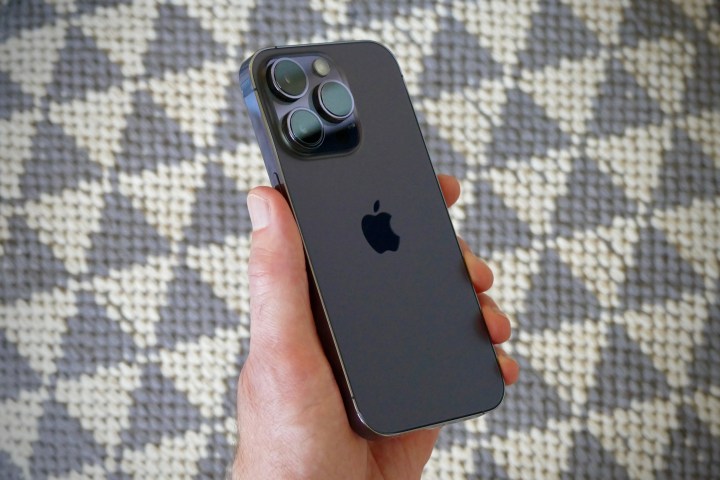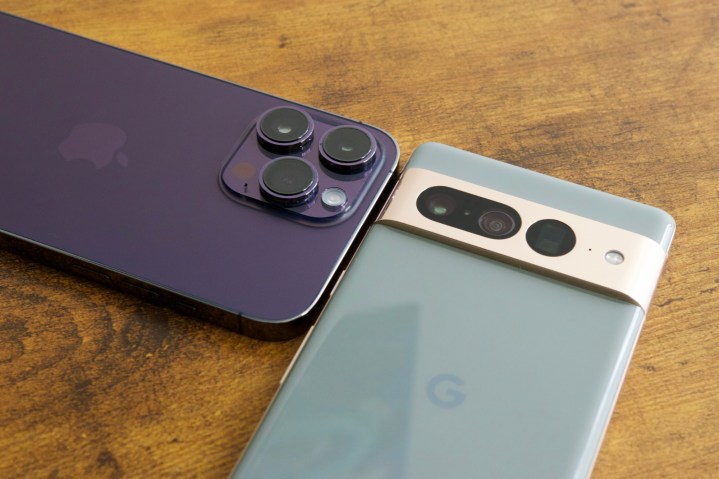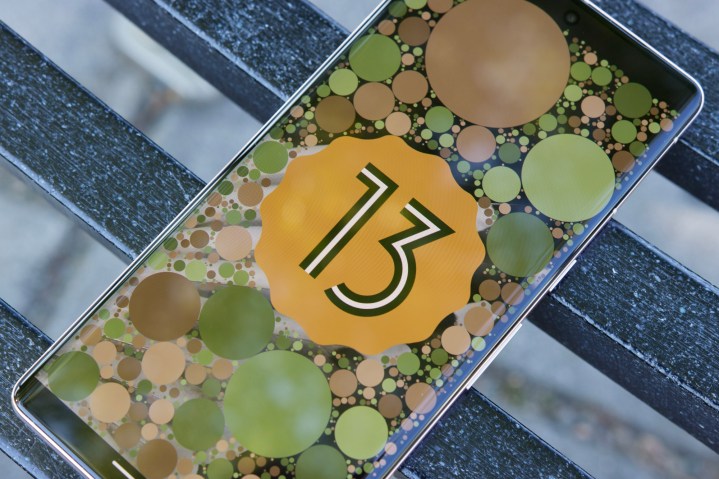The Google Pixel 7 Pro is Google’s smartphone analog to the Apple iPhone 14 Pro for those who prefer the Android operating system to Apple’s iOS. Like Apple’s iterative design approach to upgrading its smartphones, Google’s new flagship smartphone range stays consistent with its own previous models in overall appearance and features but provides under-the-hood improvements to entice customers to purchase, upgrade, or switch. Both companies are vying for your hard-earned dollars and promise the best smartphone experience, so let’s see what they have to offer.
Specs
| Google Pixel 7 Pro | Apple iPhone 14 Pro | |
|---|---|---|
| Size | 162.9 by 76.6 by 8.9mm (6.4 by 3.0 by 0.3 inches) | 147.5 by 71.5 by 7.85mm (5.81 by 2.81 by 0.31 inches) |
| Weight | 212 grams (7.5 ounces) | 206 grams (7.27 ounces) |
| Screen | 6.7-inch always-on QHD+ LTPO OLED with up to 120Hz | 6.1-inch always-on Super Retina XDR OLED with 120Hz ProMotion |
| Screen resolution | 1440 x 3120 pixels at 512 pixels per inch | 2556 x 1179 pixels at 460 ppi |
| Operating system | Android 13 | iOS 16 |
| Storage | 128GB, 256GB, 512GB | 128GB, 256GB, 512GB, 1TB |
| MicroSD card slot | No | No |
| Tap-to-pay services | Google Pay | Apple Pay |
| Processor | Google Tensor G2 | Apple A16 Bionic |
| Camera | Rear: 50-megapixel main camera, 12MP ultrawide, 48MP (telephoto)
Front: 10.8MP |
Rear: 48MP main camera (wide), 12MP ultrawide, 12MP telephoto, LiDAR Scanner
Front: 12MP TrueDepth |
| Video | Rear: 4K at 30/60 frames per second, 1080p video recording at 30/60/120/240 fps
Front: 4K at 30/60 fps |
Rear: 4K at 24/25/30/60 frames per second (fps), 1080p HD at 25/30/60 fps, HDR video with Dolby Vision up to 4K at 60 fps, slow motion 1080p at 120/240 fps, ProRes video recording up to 4K at 30 fps (256GB/512GB/1TB models only
Macro video recording |
| Cellular | 5G mmWave on select models, eSIM, NFC | 5G mmWave (U.S. models only) 5G (sub-6GHz) Dual eSIM (U.S. models only) |
| Bluetooth version | Bluetooth 5.2 | Bluetooth 5.3 |
| Ports | USB Type-C 3.1 | Lightning |
| Water resistance | IP68 | IP68 |
| Battery | 5,000mAh 30W fast charging |
3,200mAh 20W fast charging |
| App marketplace | Google Play | App Store |
| Network support | All major carriers | All major carriers |
| Colors | Obsidian, Snow, Hazel | Deep Purple, gold, silver, Space Black |
| Price | $899 | $999 |
| Available from | Apple | |
| Review | 3.5 out of 5 stars | 4.5 out of 5 stars |
Design, display, and durability

Apple’s iPhone 14 Pro is a flat hunk of gorgeous, squared-off stainless steel and glass that is famously minimalist, elegant, and simple. The Ceramic Shield material covering the screen provides excellent protection and works alongside an IP68 water-resistance rating for durability. With a 6.1-inch display, the iPhone 14 Pro model feels balanced and usable with one hand, even at 71mm wide and 7.8mm thick. It can feel slippery if used without a case, but who does that any more?
With the Pixel 7 Pro, Google presents a sleek, sophisticated exterior featuring a matte aluminum frame and glass back anchored by a compact, horizontal, modern camera bar. With its diminutive bezels and slightly rounded corners in a choice of Obsidian, Snow, or Hazel colors, the visual effect is stunning. The scratch-resistant 6.7-inch display is made with Corning Gorilla Glass Victus. There’s no irritating notch, Dynamic Island, or anything analogous to the iPhone’s built-in interface. For the Pixel, there’s only an unobtrusive hole-punch camera.
The Pixel 7 Pro does have the iPhone beat in screen resolution, with 1440 x 3120 pixels or 512 pixels per inch, compared with the iPhone 14 Pro’s 2556 x 1179 pixels at 460 ppi. One could make the case, however, that the difference in screen size between the Pixel’s 6.7-inch glass slab and the iPhone’s smaller 6.1-inch screen accounts for the overall effect of that disparity. Going strictly by the numbers gives the Pixel 7 Pro the edge. Durability-wise, the Pixel 7 Pro and iPhone 14 Pro both benefit from an IP68 rating for dust and water resistance.
It’s a tough call and ultimately comes down to your personal taste. For us, the Pixel’s sharper display just edges it.
Winner: Google Pixel 7 Pro
Performance, battery life, and charging

In terms of pure specs, the Google Pixel 7 Pro’s bigger battery beats the pants off its opponent. But, when it comes to battery life, numbers do not tell the whole story. Apple iOS has been optimized to maximize battery conservation, so it lasts as long as any other premium phone per designated interval — including the Pixel 7 Pro.
The only edge that the Pixel’s 5,000mAh battery may have over its main competitor is charging — and even that is doubtful. The Pixel features 30W fast charging, compared to the iPhone’s 20W fast charging. In addition, the Pixel has an Extreme Battery Saver mode that gives you battery life for up to 72 hours — up from the normal 24 hours. We found in testing that even with Apple’s 20W charging block, the battery charges to 50% in about 30 minutes, which is exactly the same time span Google quotes for the Pixel 7 Pro.
We’ve had a chance to test both phones under normal usage and conditions, and battery life was nothing to write home about for either handset. Real-world experience with the Pixel 7 Pro was a disappointment in that the phone basically lasted no longer than a day, regardless of its superior specs. Our reviewer cited the iPhone 14 Pro’s battery life as its least impressive quality and that it, too, lasted about a day or so.
Performance is another story, and the Google Pixel 7 Pro falls short. The more demand placed on the processor, the hotter the phone runs, warming up the handset and your hand. In contrast, our review called the iPhone 14 Pro the very best smartphone experience, so it wins this round, hands down.
Winner: Apple iPhone 14 Pro
Cameras

Apple and Google both pride themselves on having the best smartphone cameras on the market, and considering many people purchase a smartphone based on camera features, this is a critical metric.
Apple’s iPhone 14 Pro features a new 48-megapixel main camera with an f/1.78 aperture. It also has a 12MP ultrawide camera with an f/2.2 aperture and a 12MP telephoto camera with an f/2.8 aperture. The device employs Apple’s new Photonic Engine for image processing, alongside Deep Fusion and Smart HDR 4. In addition, the iPhone 14 Pro supports night mode portraits, macro shooting, instant face recognition, text to copy/paste, and the ProRAW image format. The iPhone 14 Pro also benefits from a new 12MP, f/1.9 aperture selfie cam with autofocus. These camera improvements come on top of already stellar photo specs from previous iPhone models, including 4K and ProRes video, HDR, macro, slo-mo video recording, and stabilized timelapse.
The photo and video quality of the Pixel 7 Pro camera also produced outstanding results via a large 50MP main sensor with a ƒ/1.85 aperture that focuses on detail and does justice to low-light shots. It also has a 12MP ultrawide lens with an ƒ/2.2 aperture, a 48MP (telephoto) with an ƒ/3.5 aperture, and a 10.8MP front camera with an ƒ/2.2 aperture. There’s also a 5x optical zoom and Super Res Zoom up to 30x, an extreme zoom that the iPhone does not offer. The Cinematic Blur feature is designed to take your videos to Hollywood. Real Tone keeps skin tones real for day shots, as well as Night Sight and Portrait mode. Magic Eraser removes unwanted objects and people from your photos. The Photo Unblur feature is supposed to help focus-challenged images, but in practice, it does not often live up to that promise. If your vision isn’t so hot, check out the Pixel’s Guided Frame mode that helps people take better selfies via audio and haptics. Our reviewer was disappointed in the Pixel’s fixed-focus selfie cam, which offers no opportunities for bokeh and which our review found inferior to the iPhone’s new front camera.
Both sets of cameras have many similar features, and in balance, there may not be a whole lot of difference in photo or video results for most people. Our reviewer described images from the Pixel 7 Pro as incredible and praised its ultrawide camera and its new Macro Focus shooting mode, comparing the latter to the iPhone 14 Pro. Considering both its high-level niche features in balance with its ordinary civilian picture-taking quality, the iPhone 14 Pro camera is also fantastic. We tip the scales to the iPhone because of its stellar selfie cam, but this match-up is incredibly close, as our in-depth camera comparison makes clear.
Winner: Apple iPhone 14 Pro
Software and updates

Another year, another phone, another operating system update for iPhone and Android smartphones. With the iPhone 14 range, Apple pairs the newest iOS 16, which adds plenty of new capabilities such as customizable lock screens, additional options for iMessage texts, and haptic keyboard feedback, running on the Apple A16 Bionic processor. For the high-end iPhone 14 Pro (and Pro Max), the brand-new Dynamic Island feature profoundly changes the way users interact with the phone by transforming the despised top notch. Apple promises software updates over five years for the new phone.
For Google, its new Pixel 7 Pro ships with Android 13, which features more customization for Material You, a Now Playing lock screen widget, new app permissions, and more. Android 13 is also improving for larger devices with new drag-and-drop functionality for certain apps, an updated taskbar, a more intuitive split-screen, and updated Google apps. Android runs on the Google Tensor G2 processor specifically built for the Pixel with Google’s machine learning and speech recognition plus 12GB of RAM. It promises to deliver more speed, efficiency, and security and guarantees updates for four years.
However, the new Pixel 7 Pro is one of the buggiest and glitchiest smartphones we have tested, displaying both repeated bugs and new ones emerging with extended use — so much so that it degraded the daily use of the phone and required multiple restarts every day.
Both operating systems are incredibly advanced and are tailored to these new smartphones in every imaginable way. However, Apple’s update record is stellar, and Android 13 on the Pixel is currently extremely buggy, so we’re giving this to the iPhone.
Winner: Apple iPhone 14 Pro
Special features

Apple announced two new headliner features that are critical for safety: Emergency SOS via satellite, which is coming in November, and car crash detection. Both can save lives. With Emergency SOS via satellite, if you get in a jam, you can call for help via text message from obscure places where there is no cellular service. The software walks you through how to connect to existing satellites and will funnel short messages to emergency responders. Crash detection automatically calls for emergency assistance if you get into a car accident. Many Pixel devices also have access to this, and now, so do Apple users. Another special Apple feature is the absence of a SIM card. The iPhone 14 Pro accepts only eSIM. The Pixel accepts Dual SIM tech — either a Single Nano SIM or SIM.
Google’s Pixel 7 is touted as extremely secure and private, thanks to the Google Tensor G2 and its companion Titan M2 security chip. The Pixel uses both Face Unlock and Fingerprint Unlock to allow access to the contents of your phone, though our actual experience with Fingerprint Unlock was mixed. That said, Apple is famous for its long-time security cred despite Face ID now being the preferred method of unlocking an iPhone.
We give this round to Apple for its new emergency communication and protection features. The Pixel has access to car crash detection too, but the satellite calling really pushes the iPhone over the edge.
Winner: Apple iPhone 14 Pro
Price and availability
The iPhone 14 Pro comes with 128GB, 256GB, 512GB, and 1TB of storage. It is available worldwide from a vast variety of vendors for $999, $1,099, $1,299, and $1,499 respectively. All models are available to buy via Apple’s online and physical stores and most networks in the U.S.
The Google Pixel 7 Pro is available starting at $899 for the base model with 128GB of storage. You can also buy the 256GB or 512GB model for $999 or $1,099, respectively. The Pixel 7 Pro is available from the Google Store, Amazon, Best Buy, AT&T, T-Mobile, and Verizon.
Overall winner: Apple iPhone 14 Pro
Apple’s iPhone 14 Pro has emerged on top of this competition with the new Google Pixel 7 Pro. The Pixel’s design is large, lovely, and creative, with many fine qualities, including superior screen resolution, plus water and dust resistance, an attractive high-end camera set, and, of course, a larger screen size. Apple’s new iPhone 14 Pro design may seem a bit staid to some observers, but its devoted fans appreciate its design, no-drama operating system, and professional camera specs.
We also give the nod overall to Apple because of its stellar performance and integration of critical safety features into the iPhone 14 line. Who hasn’t been lost on a hiking trail at sundown with no cell phone service? We all hope never to need crash detection, but having such life-saving features on hand will enhance the safety and well-being of all users and their loved ones. While the Pixel also has car crash detection, Apple has gone rather heavier on advertising its safety features, which makes all the difference.
Editors' Recommendations
- Which iPads does the Apple Pencil Pro work with? Here’s the full list
- Apple apologizes for its controversial iPad Pro ad
- The Google Pixel 8a’s 6 biggest upgrades over the Pixel 7a
- Best Apple deals: Save on AirPods, Apple Watch, iPad, MacBook
- There’s something Apple isn’t telling you about the new iPad Pro

